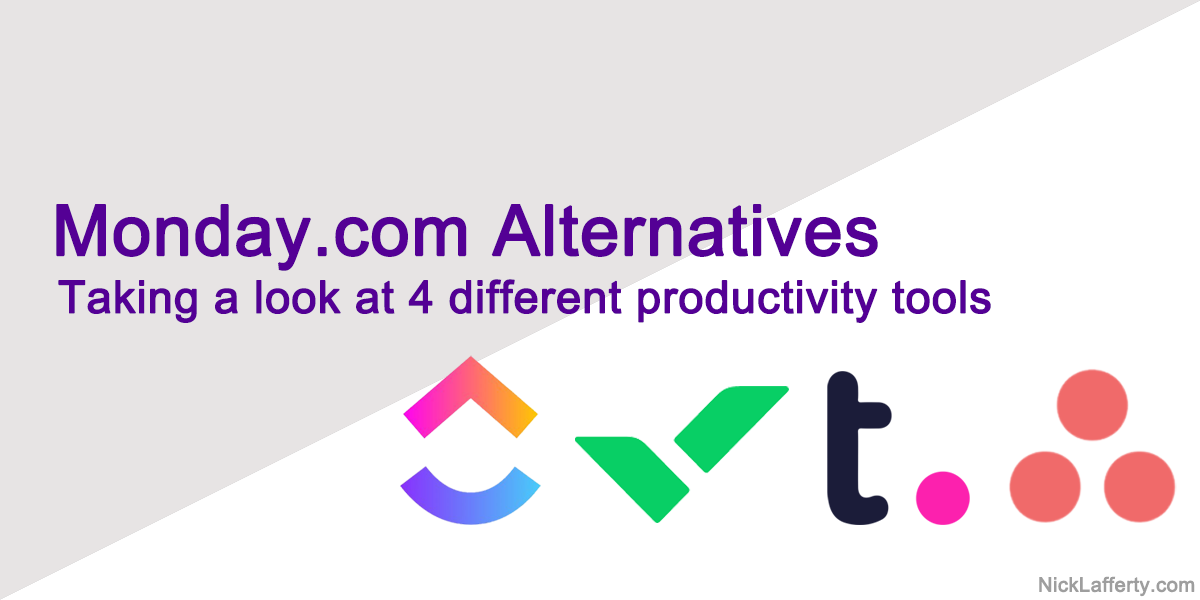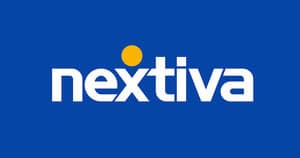
This post is sponsored by Nextiva, software that helps simplify your business with an all-in-one customer communication platform.
Try Nextiva TodayTeamwork is tricky, particularly in the business world.
Keeping everyone on the same page and working smoothly across different departments takes a huge effort.
Factor in the rise of remote work, and it’s harder than ever to effectively manage tasks and facilitate communication.
In recent years, workplace productivity tools have entered the marketplace, keen on solving this problem once and for all. But there’s only one tool that prioritizes companywide collaboration above all else — Monday.com.
Monday.com is a work management tool for teams small and large.
Whether you’re part of a 3-person team or a 300-person team, monday can help you ship more projects on time.
Sound like it might be useful?
We’ll deep dive into 4 of the best alternatives to monday.com, both free and paid, so you can make the best decision.
If you’re looking to start the work week off right, it may be time for Monday.
Best Monday.com Alternatives
What is Monday.com?

Monday, formerly known as dapulse, is business management software designed for teams.
It can be used in various business-oriented capacities, from project management and marketing pipelines to human resources and customer relationship management.
The Monday software OS provides everything your company needs, effectively transforming your phone, tablet, or desktop into an all-in-one digital workspace.
Create custom boards, add and tag tasks, then view your business' entire workflow from a Kanban, calendar, or chart lens to attain meaningful insights about overall productivity.
Monday.com is also a great Notion alternative for project managers or teams looking to collaborate on new ideas.
With user permissions, activity logs, and time-tracking, every team member can view and contribute as needed, bringing entire workplaces under one (digital) roof.
Monday is one of the largest business management SaaS' on the market, with 765 employees and a market valuation of roughly 1.8 billion.
It’s also the weapon of choice for giga-companies like Adobe, Coca-Cola, and NBC, who rely on Monday to manage company operations alongside thousands of employees.
But is Monday right for your business? Let’s find out.

This post is sponsored by Nextiva, software that helps simplify your business with an all-in-one customer communication platform.
Try Nextiva TodayMonday vs Nextiva
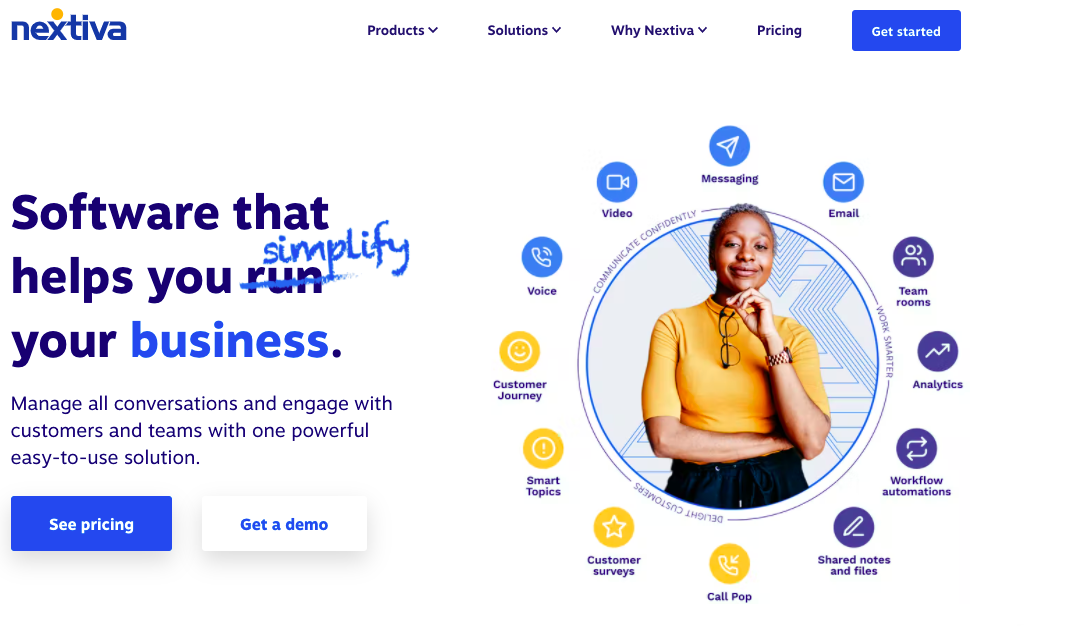
Nextiva in many ways is a completely different tool compared to monday.com
Nextiva centralizes communication from multiple channels in one place:
- SMS
- Video
- Phone
Those communication features are something monday.com lacks. Monday.com is purely a project management tool designed for teams looking to ship projects faster and in a more organized way.
But by centralizing communication, Nextiva also makes it easy to get projects done.
You can create collaboration rooms for individual projects, topics, or teams.
Important documentation or links won’t get lost because they’ll all be in one place.
And if you communicate externally with customers, you can leave notes that anyone on your team can access.
Nextiva supports video calls so you can grab some live time if anyone has a question too.
Monday vs. ClickUp
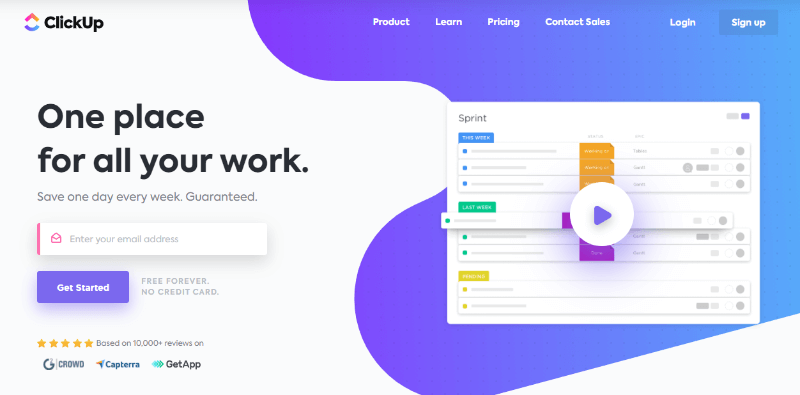
I wrote a much longer monday.com vs clickup review that you should check out.
ClickUp is the best free monday.com alternative.
ClickUp offers a free plan that comes jam-packed with an insane amount of functionality:
- board views
- goal tracking
- custom fields
- automated time tracking
Both custom fields and time tracking are only available for Monday’s Pro plan.
The major downside to ClickUp is its lack of storage. Monday’s Basic plan comes with 5GB of storage, which dwarfs ClickUp’s measly 100MB.
Pricing
ClickUp is substantially more affordable than Monday.
| Basic | Pro | Business | |
|---|---|---|---|
| ClickUp | $9 | $19 | $29 |
| monday.com | $30 | $36 | $60 |
ClickUp’s basic plan is 30% cheaper than monday.com
ClickUp’s other two plans are about 50% cheaper than monday.com.
The only catch is that monday makes you pay for 3 licenses, whereas ClickUp’s pricing is only based on individual licenses.
Free Monday Alternative
ClickUp is the best free monday alternative.
Here are the features ClickUp includes on their free plan that monday doesn’t:
- Embedded email (send and receive email directly in ClickUp)
- Unlimited Users
- Recurring Tasks
- Assign Comments
- Custom Fields
- Conversions & Chat
- Task Tray
Besides unlimited users, which is by far the most compelling difference for ClickUp’s free plan, my favorite feature is the Task Tray.
The task tray exists in the bottom right corner of your ClickUp screen, and it works exactly like a Windows task bar.
You can minimize tasks to the Task Tray so you don’t forget about them.
I like to plan my day ahead by pulling up all of my tasks and then minimizing them to the tray.
It creates a clear to-do list of tasks I want to complete that day.
That way you don’t need to open tons of tabs in your browser, everything is in one tab.
Summary
It’s hard to beat ClickUp’s free plan.
When you’re ready to upgrade their pricing is simple:
- $5/month paid annually
- $9/month paid monthly
You can save an additional 50% by paying for a year up front.
$50 may seem like a lot to pay for a tool, but it also commits you to using it.
ClickUp is a powerful way to organize your life and is a worthy monday.com alternative.
Monday vs. Wrike
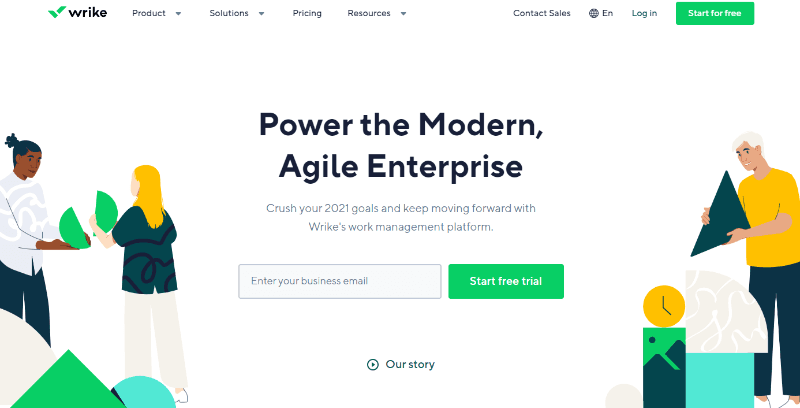
Read our full Wrike review.
Wrike is quite similar to Monday in a number of ways.
It offers most of the same features, its paid plans prioritize teamwork, and it even has a four-tier pricing structure.
The primary difference between the two? Wrike is free.
Well, it’s freemium, at any rate.
Wrike’s free plan boasts all the essential work management features you need, including boards, tasks, file-sharing amongst team members, and more.
It also comes with multiple integrations out of the box and offers 2GB storage, completely free. Think of it as half as powerful as Wrike’s Basic plan, without costing a dime. An excellent option for small teams of up to five.
Pricing
Wrike has two paid tiers compared to Monday’s three.
| Basic | Pro | Business | |
|---|---|---|---|
| Wrike | $9.80 | $24.80 | - |
| monday.com | $30 | $36 | $60 |
Like ClickUp, Wrike is also significantly cheaper than Monday.
Wrike’s free plan also gives you 2GB of storag, much higher than what ClickUp gives (100mb) and equal to Monday (2GB).
The main reason to upgrade to Wrike’s paid plan is to add more than 5 users, share dashboard, and use Gantt charts.
That boils down to if you’re using Wrike with a team of greater than 5 people or not.
Here’s a comparison of Wrike’s paid features.
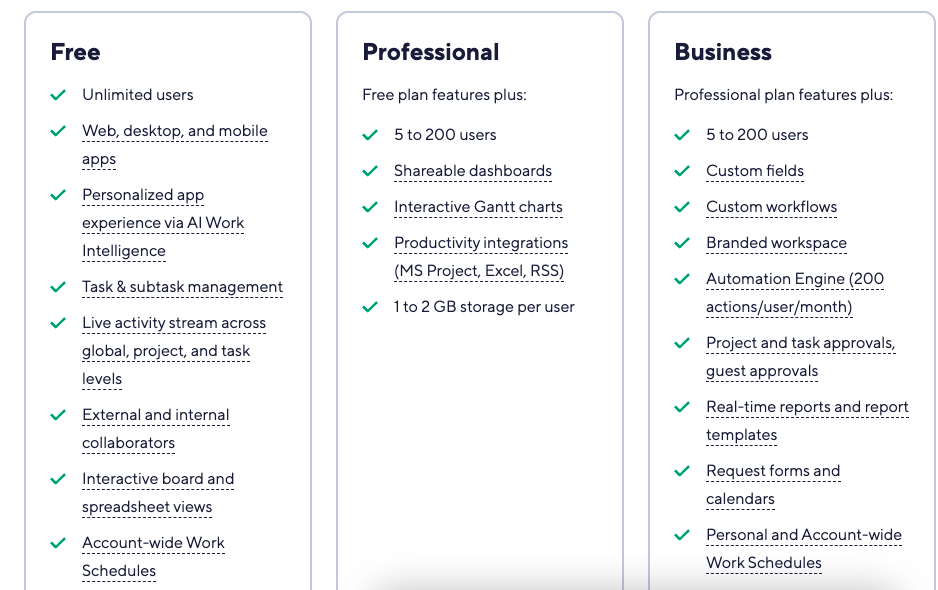
One of my freelance clients used Wrike to manage tasks so I’ve personally used it.
It’s a great tool and is priced competitively compared to monday.com
Monday vs Teamwork
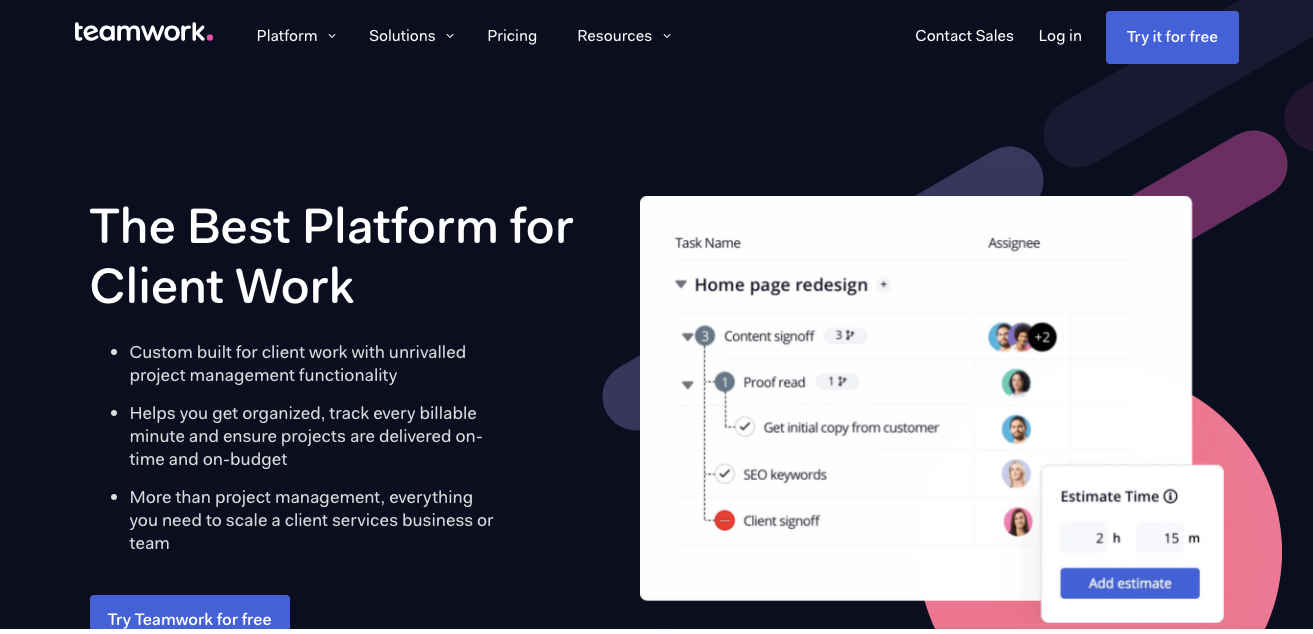
Teamwork is a project management tool that is made for client work.
If you’re an agency or a business that works primarily with clients then Teamwork could be a better choice for you.
Pricing
Continuing the theme of tools being cheaper than monday.com, here’s Teamwork’s pricing comparison.
| Basic | Pro | Business | |
|---|---|---|---|
| Teamwork | $12.50 | $22.50 | - |
| monday.com | $30 | $36 | $60 |
Teamwork also has a free plan that gives you:
- Basic project management
- Milestones
- Messages
Upgrading to their first paid tier unlocks 20 project templates, time tracking and invoicing, and intake forms.
The best features of Teamwork are gated behind their paid plan, so it’s worth upgrading if you’re using this for multiple clients.
As a freelancer myself I know the value of freelance tools to helping automate and scale your business.
Sometimes you have to shell out some money so you can save some time, and it’s totally worth it.
If you’re a larger agency then their $22.50/month plan is the better option, especially if you have Hubspot.
Teamwork has a Hubspot integration that is only available on that plan.
You can also create custom fields, get access to 50 templates, and schedule your resources.
Here’s how Teamwork’s different plans compare.

Here are two key differences between Teamwork and Monday.
Better Task Management
Monday doesn’t have subtasks or a way to create task dependencies.
That makes it difficult to take a large project and break it down into smaller pieces for your team to work on.
Imagine if a client wants you to redesign their website.
That’s not one project, it’s many small projects that add up to a brand new website.
Teamwork has subtasks so you can break those huge projects into something more manageable for your team.
Not Built For Agencies
Monday.com is simply not built for agencies, Teamwork is.
Monday tries to be a jack of all trades project management tool, and they certainly work for a lot of use cases, but client work requires a specialized tool.
Where you’ll notice this is when you want to invite clients to your board.
Monday has limited privacy features to prevent clients from seeing sensitive information or your internal communications.
When you invite 4 external guests to your Monday account you’ll be charged for 1 paid license.
That can get expensive.
Teamwork allows you to invite unlimited client users for free.
You can set their privacy settings to show them exactly what they need to see and nothing more.

This post is sponsored by Nextiva, software that helps simplify your business with an all-in-one customer communication platform.
Try Nextiva TodayMonday vs. Asana
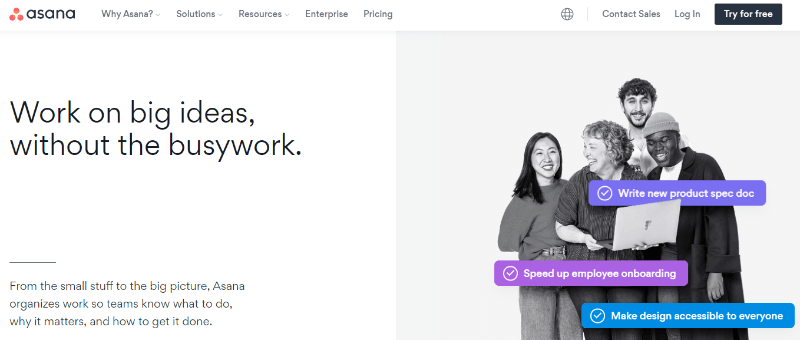
Asana may not be as feature-rich as Monday, but nor does it aim to be.
What it does aim to do is offer small and medium-sized businesses a robust platform that can handle most day-to-day work management tasks. And it does so at a fraction of the cost of Monday!
That’s right — Asana offers a free plan with tons of functionality, including unlimited projects, unlimited storage, and over 100 integrations.
Even Monday’s Pro plan can’t keep up with some of Asana’s free features.
That said, If you hope to deep dive into dozens of different project viewpoints or analyze business performance, Asana isn’t the best option.
But it’s still a respectable piece of software trusted by over 50,000 paying organizations.
Monday.com Review

When you sign up and log in to Monday for the first time, the app guides you through a short tutorial showcasing all the basic features.
You’ll see an overview of the different sections within Monday’s backend and even get the chance to create your very first board, or project hub.
The tutorial is similar to other company’s intro wizards, with one major caveat. That is, the tutorial is hardly necessary.
Monday’s UI is gorgeous, with clearly defined sections, pleasant colors, and minimal clutter.
Despite the vast quantity of features available, viewing and understand the different elements within Monday’s workspace is clear as can be.
It’s so inviting, in fact, that it’s hard to resist simply jumping in and discovering the myriad tools and features available to you!
But a word of caution.
Before you start building your new work interface, you should consider the different plans.
The last thing you want to do is spend hours creating a workflow, only to realize that the features you added are locked behind the insanely-priced Enterprise plan.
Monday Pricing
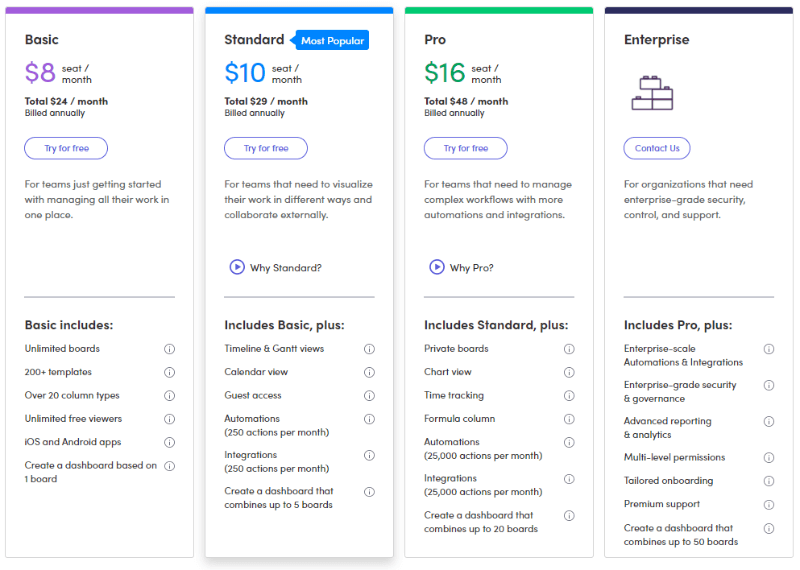
Monday offers four different pricing plans, including the Basic, Standard, Pro, and Enterprise plans.
How much does monday.com cost? Let’s break it down:
Pricing
| Plan | Pricing(Annual) |
|---|---|
| Basic | $8/month/user |
| Standard | $10/month/user |
| Pro | $16/month/user |
| Enterprise | Custom |
Although Monday’s pricing appears reasonable at first glance, it may prove too expensive for small businesses, and it’s not at all suitable for solopreneurs.
That’s because Monday requires users to purchase at least three team seats, meaning the real cost of Monday starts at $24/month for the Basic plan and $48/month for the Pro plan.
Why such a large discrepancy between pricing? Different plans offer different features, with each tier up boasting the previous tier’s functionality alongside a suite of extras.
What’s the ideal plan for your business? Well, that all depends on which features you need.
Monday Features
It’s tricky to put into words how many features Monday offers.
As an all-in-one platform for hundreds of different industries, it’s loaded with tools for managing every aspect of your business.
Let’s take a look at the different plans and the functionality you can expect from each one.
Basic Features
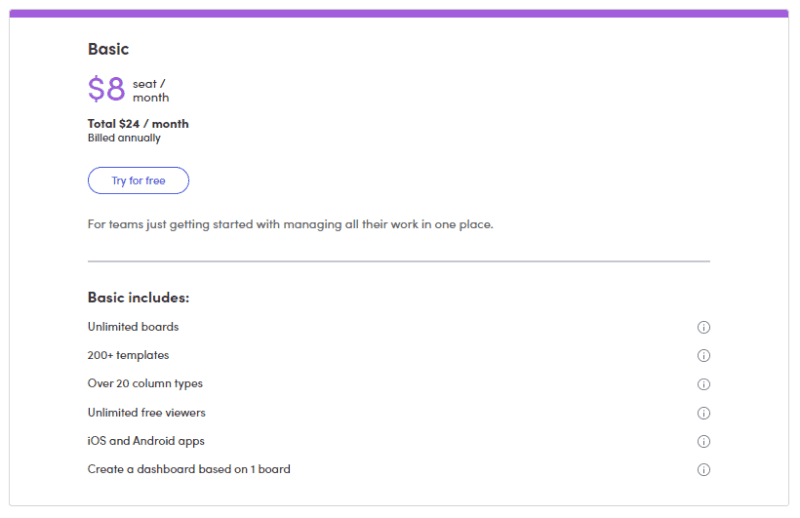
First up is the Basic plan. Since there’s no free plan, the Basic plan is Monday’s least expensive option.
Unfortunately, it lacks what many users might consider essentials, including tools like calendars, integrations, and even the ability to create project templates for your team.
That said, you do gain access to Kanban boards with various column types, basic activity logs, and a few gigabytes of storage.
But if that’s what you’re after, you’re much better off choosing something like Trello, which offers a free plan and specializes in Kanban.
To be totally honest, the fact that the Basic plan starts at $24 per month is on the extreme side, and brings Monday’s overall value down several notches.
This prices out many freelancers or solo-teams wanting to use the tool.
But it’s priced that way for a reason. Monday is built to use with other people and in a team setting.
They require you to purchase 3 user licenses almost as a way of forcing collaboration through opportunity cost.
You’re paying for 3 seats, might as well use them.
If you’re serious about using Monday, you’re way better off shelling out an extra $2 per user to access the Standard plan.
Standard Features

Next we have the Standard plan, which is where Monday starts to shine.
The Standard plan begins at $10 per user and offers the bulk of Monday’s features at a fairly reasonable monthly cost (compared to Monday’s paid competitors).
Not only do you gain access to everything within the Basic plan, but you finally gain access to calendars, helpful new board views, as well as integrations and automations galore.
You can also create bespoke templates for different projects within your business (we’ll touch more on that in a moment) and store up to 20GB of files, transforming Monday into a genuine business center.
If you’re a small to medium-sized business, this is the plan to choose.
Pro Features
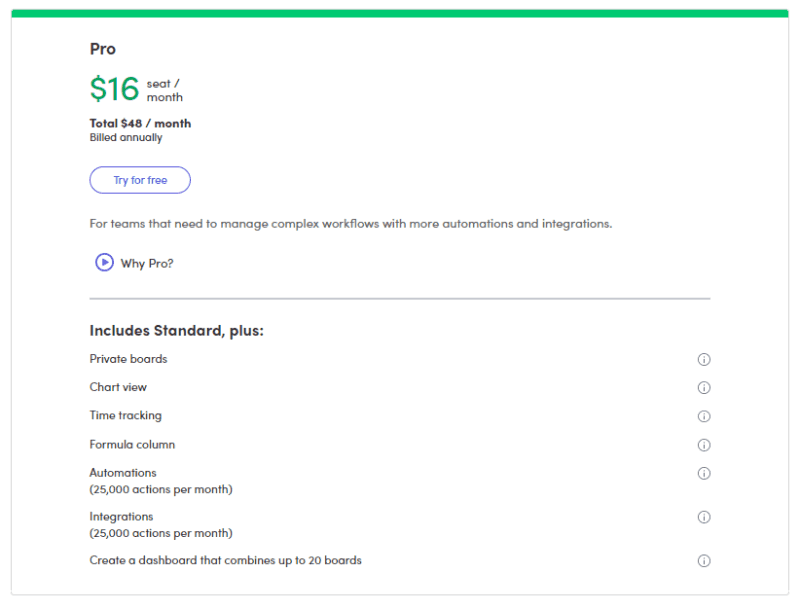
What if you’ve got a large team that requires top-tier service, and the Standard plan just won’t cut it?
That’s where the Pro plan comes in.
The Pro plan includes everything from the Basic and Standard plans, alongside enhanced and newly-released features.
This includes chart views, powerful insight-oriented dashboards, time-tracking for remote employees, and more.
The bump to 25,000 automations per month also transforms the Monday CRM into a dedicated tool capable of managing large customer bases.
And that’s not to mention the increase to 100GB of user storage, rivaling paid storage plans like Google One.
Sure, $16 per user is nothing to sneeze at, but the Pro plan is chock-full of helpful features that’ll make managing your business that much easier.
Enterprise Features
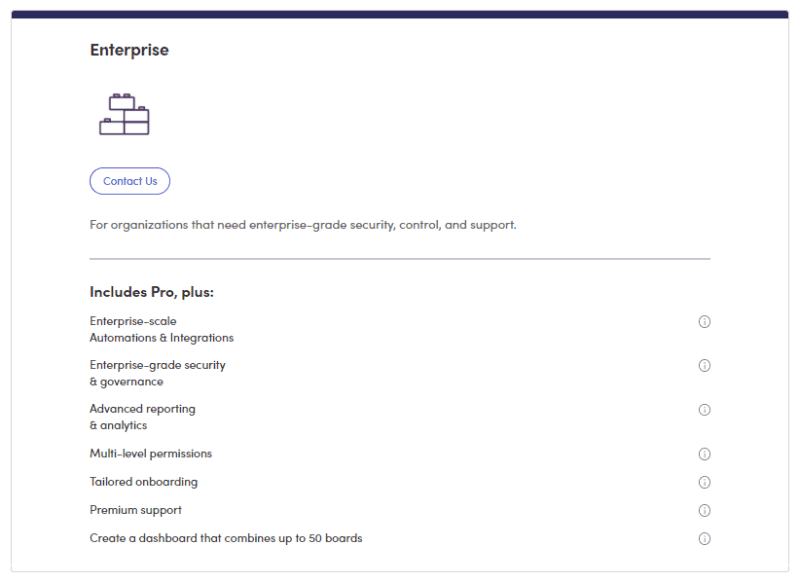
If you manage a massive and very profitable company (e.g., you’re a Fortune 5000 company), you may need to upgrade to the Enterprise plan.
This tier offers bespoke solutions like session management and advanced user permission options, as well as unparalleled customer support from the Monday team.
It essentially transforms Monday from a generic all-in-one tool into your custom work management hub.
To access the Enterprise plan, you’ll need to get in touch with Monday directly.
Monday Project Management
How does Monday.com cover so many aspects of work and project management?
And how are companies in entirely different fields — from news agencies to software developers — able to use the same tool to great effect?
It all comes down to Monday’s boards, which you can customize to your liking depending on the project at hand.
Create tasks, add columns with different data sets, assign permissions, and then send them off to your team! It may take a while to create the perfect workflow, but the control is in your hands.
Templates
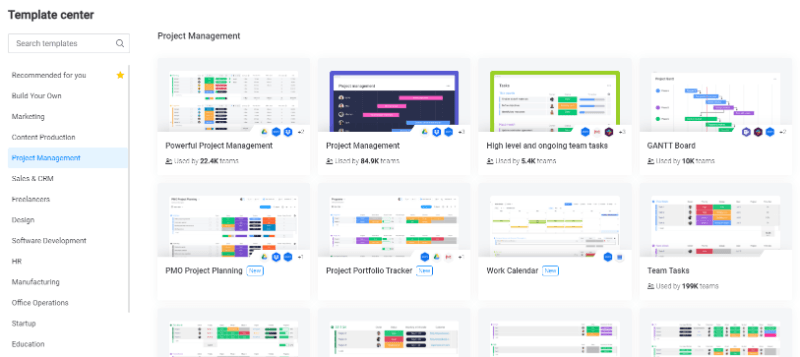
Prefer a more hands-off approach? There’s where Monday’s templates come into play.
Templates are pre-made boards with all the fields needed to handle various types of projects.
To access these templates, simply navigate to the Template Center from within Monday’s backend, and you’ll find boards designed for ventures of all types.
Customize these boards to your liking, assign tasks, and voila! Your project board is ready to go in a fraction of the time.
In addition to these generic project templates, Monday also offers hundreds of unique templates designed exclusively for particular types of businesses, including media companies, creative agencies, and loads of other industries.
What kind of templates can you find? To name just a few, Monday’s custom templates include:
- CRMs
- Project Roadmaps
- Digital Asset Management Hubs
- Content Calendars
- Email Marketing Campaign Trackers
- and so much more!
These templates can help you handle every aspect of your workflow while simultaneously keeping your entire company in the loop.
If you think about it, that’s some serious fire-power that most businesses could only dream of just a few years ago. And now it’s available to everyone for a (relatively) low monthly fee.
Jack-of-All-Trades
But that’s not to say Monday is perfect.
To be sure, Monday is a tool that attempts to wear every hat. As such, it’s not necessarily equipped to handle the nitty-gritty details within every single niche.
Remember the email marketing template I mentioned? It’s great and all, but it’s got nothing on dedicated email management tools like Mailchimp, which are laser-focused on managing singular aspects of your workflow.
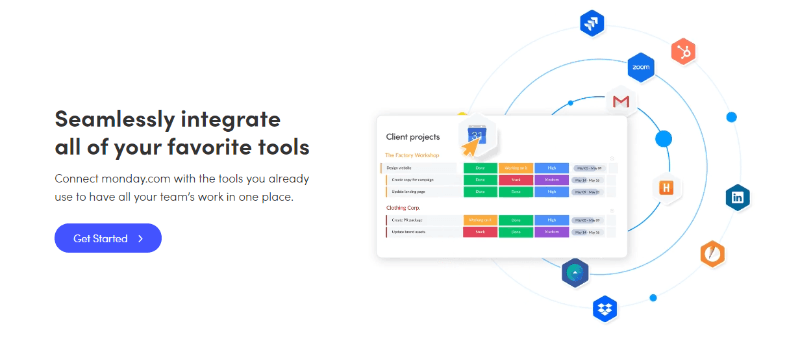
That’s the price you pay for an all-in-one platform.
It’s a jack-of-all-trades, master of none. Does that mean it’s ineffective?
Absolutely not — Monday is an excellent hub for all your projects, and the convenience it offers is well worth a few minor drawbacks.
Plus, if you need a specific feature for your project, Monday integrates with dozens of applications… including services like Mailchimp!
Monday even integrates with Zapier, which extends project functionality further still.
If you’ve got a team and need to tackle a detailed project, Monday.com is one of the best options in the industry.

This post is sponsored by Nextiva, software that helps simplify your business with an all-in-one customer communication platform.
Try Nextiva TodayFree Alternatives to Monday.com
When it comes to pricing, Monday sits in the higher echelon of work management tools.
While it’s still fairly reasonable for team-based workflows, it does have its limitations, and there’s no free plan to speak of.
So, what’s the best solution for folks on a budget?
Let’s take a look at the top Monday alternatives, starting with one that offers many comparable features without charging a dime.
Wrapping Up
monday.com is an excellent choice for team-based businesses looking to simplify their workflow and increase productivity.
No matter what industry you’re in, no matter how many team members you have to work with, Monday.com has a plan for you.
As we’ve discussed, there are two main downsides to Monday: its lack of a free plan and its three team-member minimum requirements.
If you’re looking to bypass those limitations, Wrike is an excellent free Monday alternative with many of the same features, and it supports teams of various sizes.
Either way, work management for teams has never been so easy, and you’ve got plenty of excellent options to choose from!
